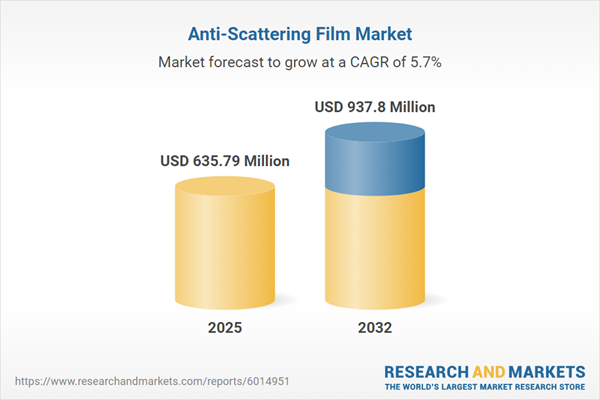Speak directly to the analyst to clarify any post sales queries you may have.
The anti-scattering film market is evolving in response to growing demand for next-generation display and optical solutions in automotive and consumer electronics. Senior decision-makers are seeking actionable insights into the strategic, technological, and regional shifts redefining performance and supply chain approaches across this dynamic industry.
Market Snapshot: Anti-Scattering Film Market
The Anti-Scattering Film Market grew from USD 601.72 million in 2024 to USD 635.79 million in 2025. It is expected to continue growing at a CAGR of 5.70%, reaching USD 937.80 million by 2032. This trajectory underscores the increasing reliance on advanced film technologies for enhancing optical clarity, minimizing glare, and ensuring product longevity in displays and coatings. The primary keyword, anti-scattering film market, encapsulates the sector's robust outlook as high-performance applications experience widespread adoption across industrial and commercial domains.
Scope & Segmentation
This executive report provides a holistic overview of industry segments and strategic focus areas:
- Product Types: Polycarbonate, Polyethylene Terephthalate
- Applications: Automotive (exterior, interior), Electronic Displays (smartphone, tablet, television), Photography (digital cameras, film cameras)
- Technologies: Roll To Roll Coating (blade coating, slot die coating), Vacuum Deposition (evaporation, sputtering)
- Coating Types: Hard Coat, Hydrophobic, Oleophobic
- Thickness Ranges: 25-50 Micron, 50-75 Micron, >75 Micron
- Regions: Americas (North America, Latin America), Europe, Middle East and Africa (Europe, Middle East, Africa), Asia-Pacific
- Leading Companies: 3M Company, Nitto Denko Corporation, Toray Industries, Mitsubishi Chemical Holdings, E.I. du Pont de Nemours, Eastman Chemical Company, Covestro AG, Toppan Printing, Chang Chun Petrochemical
Key Takeaways for Senior Decision-Makers
- Advanced anti-scattering films are integral to performance-driven coatings, supporting premium clarity, glare mitigation, and durability, especially in both displays and automotive finishings.
- Multi-layer architectures and innovative polymer composites continue to elevate functional capabilities—enabling mechanical resilience while maintaining optical transparency.
- Market participants increasingly value functional versatility, prioritizing properties such as anti-fingerprint, hydrophobic, and abrasion-resistant finishes to meet the evolving requirements of end markets.
- Collaboration is intensifying across material scientists, OEMs, and coating specialists, accelerating both technical progress and commercialization of proprietary solutions.
- Digital inspection and quality monitoring are revolutionizing manufacturing standards, supporting reliable, high-volume roll-outs and bolstering supply chain transparency.
- Regional adoption patterns present strong potential, particularly where local manufacturing, regulatory mandates, and R&D networks fuel growth corridors, such as in Asia-Pacific and North America.
Tariff Impact on Anti-Scattering Film Market
New United States tariffs imposed in 2025 add complexity to the global supply chain for anti-scattering films. With increased emphasis on sourcing agility and alternative procurement strategies, industry leaders are diversifying manufacturing footprints and reevaluating logistics operations. Forward-thinking companies are using this environment to renegotiate contracts, secure volume pricing, and pursue backward integration to strengthen access to key raw materials and mitigate tariff-driven uncertainties.
Methodology & Data Sources
This report is grounded in primary interviews with executives, engineers, and end-users, supported by secondary research from scientific literature, patents, and market publications. Rigorous data triangulation validates both qualitative and quantitative conclusions. Site visits and expert advisory panels ensured that insights reflect the realities and emerging trends within anti-scattering film manufacturing and deployment.
Why This Report Matters
- Equips stakeholders with actionable visibility on evolving segment demands, increasing both manufacturing and procurement confidence.
- Provides a clear direction for aligning R&D investment, supply chain management, and new product strategies amid a landscape shaped by regulatory and technological change.
- Supports confident market entry and expansion decisions through a balanced blend of competitive intelligence, regional opportunity mapping, and practical recommendations.
Conclusion
This analysis delivers targeted guidance to help leaders strengthen market positioning, drive innovation, and enhance operational resilience in the anti-scattering film market. By aligning technical, commercial, and strategic actions, organizations can maximize value in a sector defined by rapid evolution and rising complexity.
Additional Product Information:
- Purchase of this report includes 1 year online access with quarterly updates.
- This report can be updated on request. Please contact our Customer Experience team using the Ask a Question widget on our website.
Table of Contents
3. Executive Summary
4. Market Overview
7. Cumulative Impact of Artificial Intelligence 2025
Companies Mentioned
The companies profiled in this Anti-Scattering Film market report include:- 3M Company
- Nitto Denko Corporation
- Toray Industries, Inc.
- Mitsubishi Chemical Holdings Corporation
- E.I. du Pont de Nemours and Company
- Eastman Chemical Company
- Covestro AG
- Toppan Printing Co., Ltd.
- Chang Chun Petrochemical Co., Ltd.
Table Information
| Report Attribute | Details |
|---|---|
| No. of Pages | 185 |
| Published | November 2025 |
| Forecast Period | 2025 - 2032 |
| Estimated Market Value ( USD | $ 635.79 Million |
| Forecasted Market Value ( USD | $ 937.8 Million |
| Compound Annual Growth Rate | 5.7% |
| Regions Covered | Global |
| No. of Companies Mentioned | 10 |








